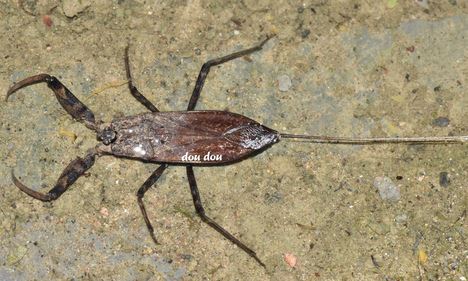This insect has a coloration ranging from medium to dark brown, with light brown to dark grey eyes. The dorsal part of the abdomen displays a hue varying from light to medium brick red or crimson, featuring occasional dark markings towards the center. The legs are medium brown, and the fore femur exhibits a narrow, sometimes interrupted whitish to pale yellow zigzag band in the distal third, while the fore tibia has a pale spot in the proximal quarter. In terms of structural characteristics, the head, pronotum, scutellum, proximal fifth of the hemielytron, and the proximal half of its costal margin are adorned with tufts of short bristles. The head is slightly wider than its median length, with recognizable clypeus and lora, and well-developed maxillary plates meeting in front of the clypeus. The vertex features a distinct median carina with a transverse depression at the level of the anterior third of the eyes, where the anterior part of the carina is higher than the posterior part. In lateral view, the eyes are positioned at the same level as the median carina. The antenna has specific proportions, and segment III is adorned with long hairs, arranged in a single or more or less double row. The pronotum possesses anterior submedian tubercles, blunt in nature, and broad submedian carinae with dorsal bluntness. The transverse groove is interrupted medially, deep and wide laterally of submedian carinae but shallow and narrow in the middle. Pronotum lateral margins are nearly straight, with slightly rounded humeral angles, and a fringe of setae is present only posterolaterally, not meeting at the posterior end. The scutellum exhibits well-developed hayfork-shaped carinae, except for the medioanterior part. The abdomen is parallel-sided in the anterior two-thirds, converging posteriorly in males, and the lateral margin is slightly convex in females. The fore leg’s femur has a distinct and relatively acute proximal tooth, and the male’s femoral groove features a small but noticeable distal tooth. The femur’s length is slightly over four times its width.
